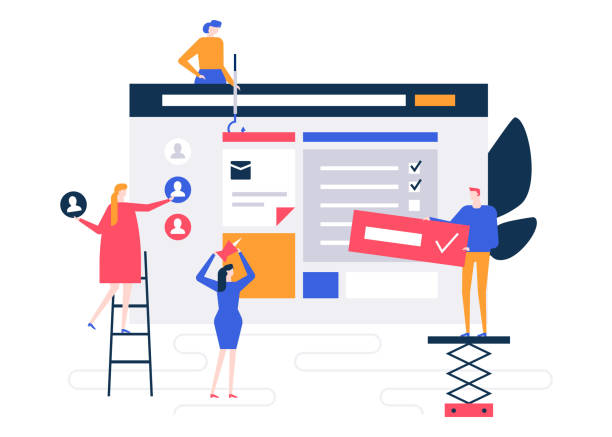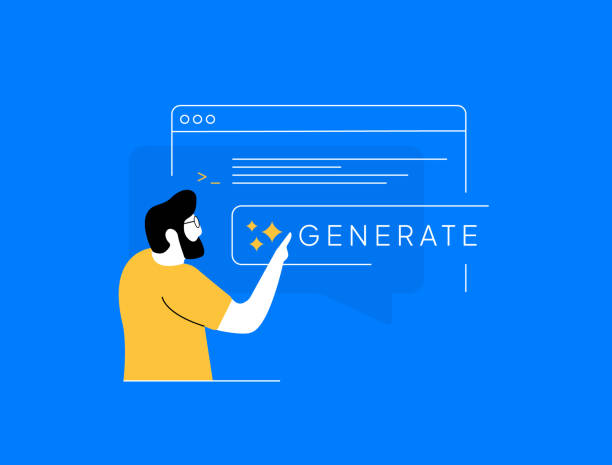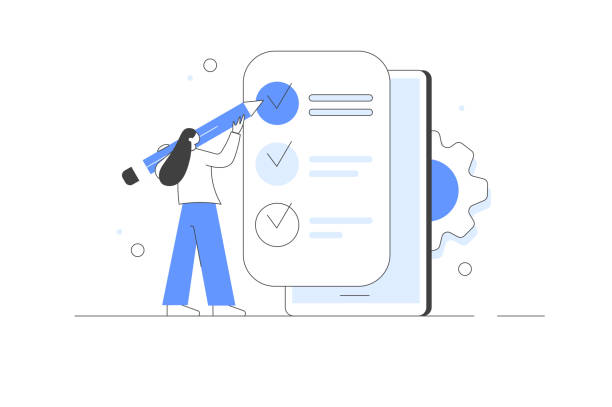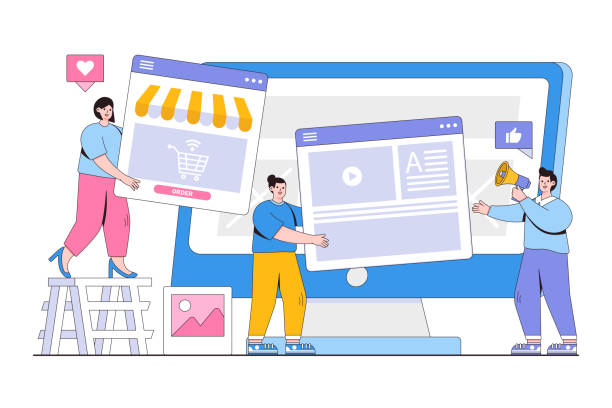Introduction to the Importance of Professional Website Design in the Digital Age

In today’s world, where the physical boundaries of businesses have blurred, having a #professional_website is no longer an option, but an undeniable necessity.
Professional website design doesn’t just mean having a beautiful appearance; it includes an optimal user experience (UX), a user-friendly user interface (UI), high speed, sufficient security, and search engine optimization (SEO).
A well-designed website will be the first point of contact for many potential customers with your brand.
This website is not only a showcase for your products and services but also a platform for building credibility and trust among your audience.
In fact, an ideal website helps you tell your brand’s story, showcase your values, and build deeper connections with your customers.
The absence of a professional website can mean missing countless opportunities in online marketing and customer acquisition.
This section, as an explanatory introduction, aims to clarify the fundamental importance of this topic for every business, regardless of its size and type of activity.
Many businesses still believe that a social media page is sufficient for an online presence, but this is a big mistake.
While social media are powerful marketing tools, your website is your brand’s main home in the digital space.
It is the only place where you have complete control over content, design, and user experience.
Imagine a user searching for your services and typing your brand name into Google; if your website doesn’t appear in the search results or offers a disappointing user experience, they will likely quickly turn to competitors.
Professional website design is more than an expense; it’s an investment in your business’s future.
This investment will lead to increased visibility, more customer acquisition, improved conversion rates, and ultimately, sustainable growth.
Have you ever considered what opportunities the lack of a powerful website has deprived you of? This is a thought-provoking question that many business managers should ask themselves.
Furthermore, with the increasing proliferation of smartphones, website responsiveness (correct display on various devices) is crucial.
Your website must be easily accessible and usable on every screen, from desktops to tablets and mobile phones.
Professional website design also includes optimizing page loading speed.
Today’s users expect websites to load within a few seconds, otherwise, they abandon the page.
All these factors, together, lead to an excellent user experience that not only attracts customers but also keeps them loyal.
Therefore, investing in a specialized team for professional website design is considered an essential step for any leading business.
This is the first step towards an effective and powerful presence in the digital world.
Falling behind in the competition with large online stores?
RasaWeb makes your business online and increases your market share with professional e-commerce website design!
✅ Increase brand credibility and customer trust
✅ Easy shopping experience leads to more sales
⚡ Act now to receive a free consultation for website design!
The Role of User Experience (UX) and User Interface (UI) in Professional Website Design

To achieve an #efficient_website, a deep understanding of the differences and synergy between User Experience (UX) and User Interface (UI) is essential.
These two concepts, although often used interchangeably, play distinct and complementary roles in professional website design.
UX or User Experience refers to how a user feels when interacting with your website.
Is the website easy to navigate? Is the information the user needs easily found? Is the purchasing or registration process simple and unambiguous? All these questions relate to user experience.
The primary goal of UX design is to improve user satisfaction by increasing accessibility, efficiency, and pleasure in using the website.
This includes user research, persona creation, user journey mapping, and usability testing.
In fact, UX is an analytical and strategic approach that focuses on user needs and behaviors.
In contrast, UI or User Interface pertains to the website’s visual appearance and feel.
This includes colors, typography, buttons, icons, and all visual elements with which the user interacts.
A good UI is not only beautiful but also intuitive and understandable.
Professional website design requires a UI that is visually appealing while also guiding the user throughout the website.
Imagine a website with excellent information and numerous features, but with a cluttered layout and inappropriate colors; this website will never be able to attract and retain users, even if its UX is good.
In essence, UI is the bridge through which UX is conveyed to the user.
This section is an educational explanation to clarify the importance of these two concepts together.
To achieve a powerful and user-friendly website, coordination between UX and UI is crucial.
A good UX designer first researches what users need and how they want to interact with the website, then a UI designer transforms these findings into a beautiful and functional visual design.
This collaboration ensures that the website is not only visually appealing but also efficient and enjoyable for users.
Without attention to UX, even the most beautiful UI will be useless, and without a strong UI, the best UX might not be effectively conveyed.
A professional website design always balances these two to bring the best results for the business and its users.
Investing in these two aspects guarantees your website’s long-term success.
Speed and Responsiveness: Key Factors in Professional Website Design

In today’s fast-paced world, your website’s loading speed and #responsiveness are two critical factors for success in professional website design.
Users expect websites to load within a few seconds, and any delay can lead to a loss of visitors.
Research shows that even a one-second delay in page load time can result in a 7% reduction in conversions and an 11% reduction in page views.
This is a specialized point that directly impacts your business’s profitability.
Website speed not only affects user experience but is also an important factor in search engine rankings like Google.
Google gives higher scores to websites that load quickly, which in turn leads to greater visibility in search results.
To improve website speed, various strategies exist, including image optimization, file compression (CSS, JavaScript, HTML), using browser caching, and choosing suitable hosting.
Using a Content Delivery Network (CDN) can also significantly increase website loading speed for users accessing your website from more distant geographic regions.
Alongside speed, website responsiveness is of paramount importance.
Given that over half of internet traffic comes from mobile devices, your website must be able to adapt to different screen sizes.
A professional website design ensures that your website is equally beautiful and functional on desktops, laptops, tablets, and smartphones.
Lack of responsiveness can lead to a poor user experience and ultimately abandonment of the website by mobile users.
This section, as a comprehensive guide, provides tools for evaluating and improving these two vital aspects.
This table helps you understand the key metrics related to website speed and responsiveness:
| Metric | Description | Importance |
|---|---|---|
| LCP (Largest Contentful Paint) | Time when the largest content element on the page becomes visible. | Main criterion for page loading speed from the user’s perspective. |
| FID (First Input Delay) | Time when the browser responds to the first user interaction. | Measures the website’s responsiveness to user input. |
| CLS (Cumulative Layout Shift) | Visual stability of the page; degree of page element movement. | Prevents unwanted layout shifts during loading. |
| Responsive Pixels | Using relative units (like em, rem, %) instead of fixed px. | Ensures correct display on different screen sizes. |
Both speed and responsiveness are considered fundamental pillars in professional website design, and neglecting them can harm your website’s credibility and search engine ranking.
Search Engine Optimization (SEO) in Professional Website Design

For your website to be seen by potential customers, #Search_Engine_Optimization (SEO) is a vital factor.
Professional website design without attention to SEO is like building a beautiful store in a remote desert.
You might have the best products or services, but if no one can find you, your business won’t grow.
SEO is the process that prepares your website for higher rankings in organic (non-paid) search results of search engines like Google.
This includes content optimization, technical website structure, and acquiring links from other websites.
Understanding search engine algorithms and their continuous updates is a specialized task that requires knowledge and experience.
This section guides you on how to incorporate SEO fundamentals into your design process.
One of the key aspects of SEO is choosing appropriate keywords.
You need to identify the words your target customers use to find your products or services.
Then, naturally incorporate these keywords into your website content, titles, meta descriptions, and URLs.
But SEO is not limited to keywords alone.
Technical SEO is also highly important.
This includes aspects like friendly URL structure, sitemap (sitemap.xml), robots.txt file, and proper use of canonical tags.
A technically optimized website helps search engines correctly index and crawl your pages.
These aspects might not be visible, but they are crucial for professional website design aiming for long-term visibility.
From an analytical perspective, without strong SEO, even the best user experience cannot provide the necessary traffic for the website.
Furthermore, high-quality and valuable content plays a very important role in SEO.
Search engines prioritize content that is useful and relevant to users.
Creating fresh and updated content, including blog articles, guides, videos, and infographics, can increase your website’s authority and attract natural backlinks from other websites, which is a significant ranking factor.
A comprehensive SEO strategy also includes optimization for local search, especially for businesses with a physical presence, as well as social media marketing to boost social signals.
Professional website design should be carried out from the outset with SEO principles in mind to achieve desired results as quickly and sustainably as possible.
Research shows that 80% of customers trust companies with professional websites more. Does your current website inspire this trust?
With RasaWeb’s corporate website design services, solve the problem of customer mistrust and a weak online image forever!
✅ Create a professional image and increase customer trust
✅ Attract more sales leads and grow your business
⚡ Get a free consultation now
Content Strategy and Call to Action (CTA) in Professional Website Design

Content is king, and this phrase literally holds true in the world of #functional_website_design.
A professional website design without a strong content strategy is like a beautiful library without books.
Your content should be useful, engaging, and relevant to your audience’s needs.
This includes text, images, videos, infographics, and anything that conveys information to the user.
The goal of content strategy is not only to attract visitors but also to convert them into customers.
Educational and guiding content can enhance your credibility as an expert in your industry and build user trust.
Does your website’s content answer common customer questions? Does it offer solutions to their problems? These are important questions that must be addressed in website design.
Beyond textual content, the Call to Action (CTA) is one of the most important elements on any website.
CTAs are buttons or links that encourage users to perform a specific action, such as “Shop Now”, “Contact Us”, “Sign Up”, or “Free Download”.
Placing clear and compelling CTAs in strategic locations on the website plays a vital role in increasing conversion rates.
A professional website design guides the user towards the main CTAs and makes the action process easy and intuitive for them.
The color, size, placement, and text of the CTA must all be carefully chosen to maximize impact.
This is a specialized aspect of design related to user psychology and digital marketing.
To maximize effectiveness, your content should be regularly updated and aligned with market needs and technological changes.
Blogs and news sections can be excellent sources for generating fresh content.
News content can keep audiences informed about the latest developments in your industry and bring them back to your website.
Additionally, entertaining and interactive content such as quizzes, surveys, or engaging videos can increase user time on your website and enrich the user experience.
A professional website design should provide a platform for offering this content diversity.
The ultimate goal is for every visitor to become a loyal customer, and this is only achievable through valuable content and effective CTAs.
Continuous analysis of content and CTA performance (e.g., through tools like Google Analytics) is essential for continuous improvement.
This section is an educational guide on how to plan for your website’s content success.
Website Security and Maintenance After Professional Design

After the completion of #luxury_website_design and its launch, the work doesn’t end; it only just begins.
Website security and maintenance are two main pillars for preserving its proper functioning and stability in the long run.
A professional website design includes strong security protocols to protect user data and your business’s sensitive information against cyberattacks, malware, and intruders.
Without adequate security, your website can easily become a target, leading to data loss, damage to brand reputation, and even legal penalties.
Did you know that the smallest vulnerability can be a gateway for hackers? This is a thought-provoking question that you should consider throughout the design and maintenance process.
One of the first steps to ensure security is installing an SSL certificate (Secure Sockets Layer), which encrypts communications between the user’s browser and the website server.
This not only builds user trust (by displaying a lock icon in the address bar) but is also an important ranking factor for search engines.
Additionally, using strong passwords, regularly updating the Content Management System (CMS) like WordPress and its plugins, and regularly backing up website data are among the specialized and vital measures for maintaining security.
These actions, as a comprehensive guide, prevent serious problems from occurring.
Website maintenance goes beyond security and includes various aspects.
Checking for broken links, database optimization, cache clearing, monitoring website performance, and ensuring compatibility with different browsers are all regular maintenance activities.
These activities ensure that your website always operates at maximum efficiency and provides an optimal user experience.
A proactive maintenance plan can prevent major problems in the future and reduce potential costs from emergency repairs.
This is a type of cost-benefit analysis.
For professional website design, a comprehensive maintenance and security plan should be developed from the outset.
Some companies offer monthly or annual maintenance services, which can give you peace of mind regarding your website’s health and security.
This section, as a complete explanation, addresses the importance of these topics and provides solutions.
Essential Tools and Technologies for Professional Website Design

To implement a #smart_and_efficient_website, familiarity with the latest tools and technologies is essential.
Professional website design in the current era relies on a set of programming languages, frameworks, Content Management Systems (CMS), and design tools.
The correct selection of these tools can make a significant difference in development speed, efficiency, scalability, and website maintenance costs.
This section provides a specialized explanation of the available options and the reasons for choosing each.
Are you looking for a custom solution or a ready-made platform? This is an important question that needs to be answered before starting the project.
In the field of programming languages, HTML (Hypertext Markup Language), CSS (Cascading Style Sheets), and JavaScript are the three main foundations of every website.
HTML defines the content structure, CSS controls the appearance and layout, and JavaScript adds dynamic interactions to the website.
For the backend (server-side), languages like PHP, Python (with frameworks like Django or Flask), Ruby (with Rails), or Node.js (JavaScript on the server-side) are very popular.
Each of these has its own advantages and disadvantages, and their selection depends on the project’s needs and scale.
This section, as a comprehensive tutorial, helps you understand these technologies.
Content Management Systems (CMS) like WordPress, Joomla, and Drupal allow for website creation and management without requiring deep programming knowledge.
WordPress, due to its high flexibility and numerous plugins, is the most popular CMS in the world and is suitable for various types of websites, from personal blogs to large online stores (with WooCommerce).
Graphic design tools such as Adobe XD, Figma, and Sketch are also essential for User Interface (UI) and User Experience (UX) design.
These tools enable the design of wireframes, prototypes, and website mockups before coding.
Professional website design not only requires programming knowledge but also a deep understanding of these tools and platforms.
This table shows some of the common tools and technologies in professional website design:
| Category | Tool/Technology | Description/Application |
|---|---|---|
| Frontend Languages | HTML, CSS, JavaScript | Basis for website structure, styling, and interactivity. |
| Frontend Frameworks | React, Angular, Vue.js | For building complex and single-page user interfaces. |
| Content Management Systems (CMS) | WordPress, Joomla, Drupal | Easy content management without coding. |
| UI/UX Design Tools | Figma, Adobe XD, Sketch | For designing wireframes, prototypes, and website mockups. |
| Backend Languages | PHP, Python, Node.js, Ruby | Data processing, database interaction, and server-side logic. |
The correct selection of these tools, along with a specialized team, will pave your way for a professional website design.
Budget and Return on Investment (ROI) in Professional Website Design

Investing in #business_website_design is a strategic decision that can bring significant returns for your business.
But the main question is: “How much should be spent on professional website design, and how can its Return on Investment (ROI) be ensured?” The cost of website design can vary greatly, depending on the project’s complexity, number of pages, specific functionalities (such as an online store, booking system, user portal), level of customization, and the experience and reputation of the design team.
Simple websites might be designed at lower costs, while complex and fully customized websites can cost tens of millions of Tomans or more.
This is an important analytical assessment that every business should undertake before starting a project.
To determine an appropriate budget, you must first clearly define your website’s goals.
Is the main goal lead generation, direct sales, providing information, or creating a communication platform? Each of these goals requires different functionalities and design, consequently affecting the final cost.
A professional website design should be such that it achieves these goals.
Also, it’s important to consider additional costs in your budget, such as domain purchase, hosting, SSL certificate, annual maintenance, content updates, and digital marketing (SEO, PPC, etc.).
These are ongoing costs essential for maintaining the website’s performance and visibility.
Return on Investment (ROI) in professional website design refers to the commercial value your website brings after deducting costs.
This value can include increased sales, reduced marketing costs (due to organic traffic acquisition), increased brand awareness, improved customer service, or even enhanced internal efficiency.
To measure ROI, you need to monitor Key Performance Indicators (KPIs) such as conversion rate, website traffic, bounce rate, user time on site, and the number of leads generated.
Using tools like Hotjar for user behavior analysis and Google Analytics for tracking traffic data is essential.
This section serves as a guide to help you make informed financial decisions.
A low-cost website that is poorly designed can ultimately incur higher costs due to failure to attract customers or the need for frequent redesigns.
In contrast, investing in high-quality professional website design can yield significant long-term profitability and contribute to your business’s sustainable growth.
This is an educational explanation on how to view website costs not as an expense, but as a long-term investment.
Are you frustrated by losing customers due to your e-commerce site’s outdated appearance or slow speed? RasaWeb’s expert team solves these problems with professional e-commerce website design!
✅ Increase customer trust and your brand’s credibility
✅ Blazing fast speed and excellent user experience
Get a free consultation with RasaWeb right now ⚡
Choosing a Professional Website Design Team and the Importance of Portfolio

Choosing the right #website_design_team is perhaps one of the most critical decisions on the path to achieving a professional website design.
This decision not only affects the final quality of your website but can also impact your budget, timeline, and ultimately your business’s success.
How can you find a suitable team that not only possesses the necessary technical skills but also understands your vision and translates it into reality? This is a thought-provoking yet key question that requires careful consideration and review.
The first step in selecting a team is to review their portfolio (sample works).
A portfolio is a mirror of a team’s capabilities, design style, and past experience.
When reviewing a portfolio, pay attention to the following: Are their previous websites visually appealing? Are they responsive and display well on different devices? Do they offer a good user experience (UX)? Does the diversity of projects indicate their ability to work with various industries? Also, pay attention to the loading speed and overall performance of the websites they have designed.
A strong portfolio demonstrates the team’s commitment to quality and attention to detail.
This section provides a comprehensive guide for evaluating portfolios.
Beyond the portfolio, communication and transparency throughout the design process are of paramount importance.
A professional website design team should allow you to be involved in all stages of the project, from initial conceptualization to final launch.
They should answer your questions, accept your feedback, and regularly report on work progress.
Strong communication skills are a sign of the team’s professionalism.
Also, reviewing previous client testimonials and obtaining references can give you good insight into the team’s work style and client satisfaction.
Do they deliver projects on time? Do they provide good support if problems arise? These are vital questions.
Look for a team that not only excels in design and coding but also has a good understanding of digital marketing, SEO, and business strategy.
A comprehensive team can help you build a website that is not only beautiful but also contributes to your business goals.
Professional website design is a complex process that requires various specializations.
Choosing the right design partner ensures that your investment yields the best possible results.
This section, as a complete explanation, helps you make the best decision for your business’s online future.
The Future of Professional Website Design and Emerging Trends

The world of #advanced_website_design is constantly changing and evolving, and awareness of emerging trends is essential for maintaining a #competitive_website.
A professional website design doesn’t just mean adhering to current standards; it also involves anticipating and adapting to future changes.
In this section, we examine some of the most important news and analytical trends shaping the future of website design.
Is your website ready to embrace new technologies?
One of the most important current trends is an increased focus on personalization and Artificial Intelligence (AI).
Websites are increasingly using AI to provide personalized experiences to users, such as product recommendations based on purchase history, customized content, and smart chatbots for customer support.
This not only improves the user experience but also increases conversion rates.
Additionally, Voice User Interface (VUI) design is gaining popularity.
With the widespread use of voice assistants like Siri and Google Assistant, websites need to be optimized for voice search.
This involves using natural language and question-and-answer content.
Other trends include Virtual Reality (VR) and Augmented Reality (AR) on websites, especially for online stores and interactive platforms.
Imagine customers being able to view a product in 3D in their own home or experience a virtual space.
These technologies can elevate the online shopping experience to a whole new level and have great potential for entertaining interactions.
Single Page Applications (SPAs) will also continue to maintain their popularity due to their high speed and smooth user experience, especially for websites that do not require continuous content updates.
Furthermore, sustainability and energy optimization in web design are also becoming an important topic.
Websites that are energy-efficient not only help the environment but can also save on hosting costs.
This is a specialized and growing aspect that web designers should pay attention to.
Ultimately, professional website design in the future will move more towards intelligence, high interactivity, and sustainability.
By keeping pace with these trends, your business can remain a leader in the digital world and maintain its competitive advantage.
This section is an educational guide on the future outlook of web design.
Frequently Asked Questions
| Question | Answer |
|---|---|
| What does professional website design mean? | Professional website design refers to creating a user-friendly, visually appealing, fast, secure, and search engine-optimized website that meets business goals. |
| What are the most important features of a professional website? | Responsiveness, high speed, security, SEO-friendliness, excellent User Experience (UX) and User Interface (UI), high-quality content, and strong branding. |
| Why is responsive design crucial for a professional website? | Responsive design ensures that your website displays correctly on any device (computer, tablet, mobile), which is very important for user experience and Google ranking. |
| What is the role of UI and UX in professional website design? | UX (User Experience) focuses on ease of use and user satisfaction, while UI (User Interface) deals with the visual appearance and user interaction with the website. Both are essential for attracting and retaining an audience. |
| What is the place of SEO in professional website design? | SEO is one of the main pillars. A professional website must have a strong technical structure, optimized content, and high speed to achieve a good ranking in search engine results and be seen. |
| What tools or platforms can be used for professional website design? | Content management platforms like WordPress, Joomla, or Drupal; web development frameworks like React, Angular, or Vue.js; and graphic design tools like Figma or Adobe XD. |
| What are the main stages of professional website design? | Planning and research, wireframe and mockup design, development and coding, content entry, testing and review, and finally launch and maintenance. |
| What is the importance of security in a professional website? | Website security is crucial for protecting user information and business credibility. Using SSL/TLS, firewalls, regular backups, and updates are vital measures. |
| Does a professional website require maintenance after launch? | Yes, regular maintenance including software updates, checking for broken links, monitoring performance, backups, and adding fresh content is essential for maintaining website efficiency and ranking. |
| What distinguishes a professional website from an amateur one? | A professional website focuses on business goals, provides an unparalleled user experience, adheres to high technical standards, and is continuously optimized for improvement, while an amateur website typically lacks these features. |
And other services of RasaWeb Advertising Agency in the field of advertising
Smart Digital Advertising: Transform campaign management with key page optimization.
Smart Link Building: A fast and efficient solution for online growth, focusing on key page optimization.
Smart Marketplace: An effective tool for analyzing customer behavior through user experience customization.
Smart Conversion Rate Optimization: Transform SEO ranking improvement with custom programming.
Smart Data Analysis: A novel service for increasing SEO ranking improvement through attractive user interface design.
And over hundreds of other services in internet advertising, advertising consulting, and organizational solutions
Internet Advertising | Advertising Strategy | Advertorials
Resources
Websima Website Design ServicesIranHost Website DesignRocket Web Design Getting Started GuideBemanTech Professional Website Design
? Rasaweb Afarin Digital Marketing Agency, your trusted partner on the path to online growth!
For more information about our professional services, including WordPress website design, we are ready to elevate your business to its peak.
📍 Tehran, Mirdamad Street, next to Bank Markazi, Kazerun Jonubi Alley, Ramin Alley, No. 6



